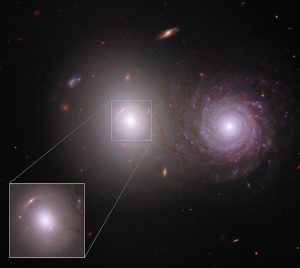
From the galaxy zoo blog entry by UA Professor Bill Keel:
“In our first looks at the JWST data, something else became obvious. Near the core of the elliptical galaxy VV191a is a very red arc appearing to partly wrap around its nucleus. Opposite the nucleus is a much smaller red spot. Together these fit perfectly for being a gravitational lens, light from a galaxy over 10 billion light-years away, seen as the gravity of the foreground galaxy distorts and magnifies it. While hundreds of such lenses are known from more distant galaxy clusters (eagerly sought to improve our knowledge of very early galaxies), only a handful of single-galaxy lenses have been found so nearby.”
“The dust in the spiral arms of the big spiral (VV191b) stands out where it is silhouetted by the bright light of the elliptical galaxy VV191a. In fact, the dusty arms can be traced farther from the spiral’s center than … the … bright spiral arms, cutting off very sharply at a radius of 20 kiloparsecs (66,000 light-years, about 8 times the distance from us to our own galactic center). This testifies to the past history of star formation in VV191b.”
The images represent a great demonstration of the power of HST and JWST together and were highlighted in a recent release.